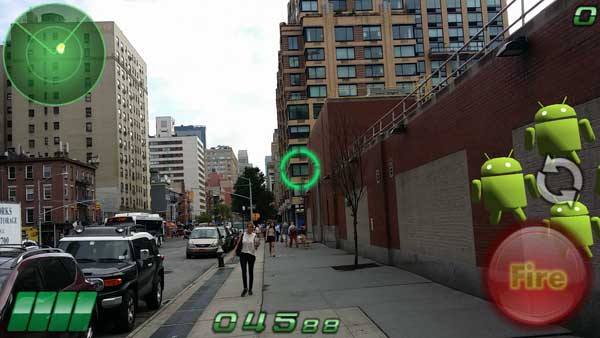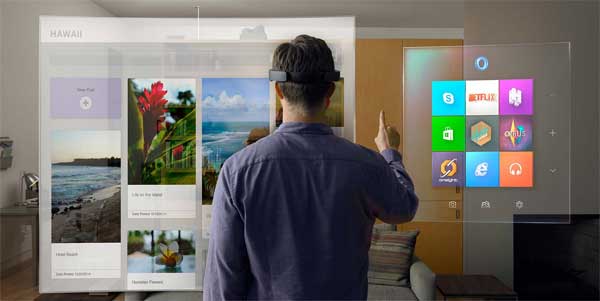HoloLens Finally Makes Augmented Reality Real
Our AR future is almost here. Microsoft's Windows Holographic will do for Augmented Reality what iPad did for tablets: inspire an industry.

Augmented reality headsets are the "flying cars" of computing; we've been dreaming about them for a long time, but they're always relegated to the far-flung future. However, with Microsoft's new HoloLens device, we could finally be entering the era of AR, the biggest change in computer interfaces since we moved from DOS to Windows.
The concept of augmented reality, the process of imposing virtual objects and data on top of your real-world field of view, has been around almost as long as virtual reality, but it has yet to go mainstream. Back in the 1980s, many of us saw our first glimpse of AR in Terminator 2, when Arnold Schwarzenegger's character looks at people in a bar and sees text information about them appear around their bodies.
MORE: HoloLens Hands-On
We haven't gotten Terminator eyes yet, but we've seen a number of AR applications on phones. Google Goggles and Amazon Firefly scan objects in front of you and return information about them. Wikitude shows restaurant reviews and information about landmarks on screen as you point your phone at buildings. Games like DroidShooting impose virtual characters on top of your real surroundings. Custom applications help technicians perform repairs by showing digital instructions on top of the real-world equipment they're working on.

You can only spend so much time holding your phone up in front of restaurant signs and soda cans before you get a sore wrist, get bored and stick the handset back in your pocket. For augmented reality to really work, we need a device that puts the action right in front of our eyes.
Up until now, we haven't had a mainstream augmented reality headset. Google Glass puts a computer screen above one of your eyes, but it has few AR apps and functions more like a cheap smartphone on your face than immersive goggles. Oculus Rift and Samsung Gear VR are over-the-head devices, but they focus on virtual reality, which takes over your world rather than enhancing it. Startup Meta has been working on some really exciting AR glasses with its own, custom interface and is at the stage of shipping developer kits.
MORE: I Am Iron Man: My Time with the Meta 1 AR Glasses
Get instant access to breaking news, the hottest reviews, great deals and helpful tips.
Microsoft's HoloLens glasses and the Windows Holographic OS that powers them could be the big AR break we've been waiting for. Just don't tell that to Microsoft, which didn't use the term "augmented reality" when announcing its new platform, opting to inappropriately use the term "hologram" to describe virtual objects viewed only through glasses. However you brand it, Windows Holographic is a game changer that combines the virtual world of your computer with the real world of your home or office.
With HoloLens, you will be able to pin shortcuts or applications to physical locations in your house. "Honey, have you seen my glasses?" could be replaced by, "Do you know where I left my Word document?" I can imagine a future in which the virtual objects from Windows Holographic and real-world objects with Bluetooth tracking are all findable in the OS. Searching for "wallet" would then inform you that your physical wallet is in the bedroom closet, a file called "wallet-expenses.xls" is pinned to your office wall and a Web page about Google Wallet is just one click away.
MORE: Microsoft Adds 3D Holograms to Real World
More important, with HoloLens, you'll be able to turn any wall into a screen for work or video chats, no projector required. You'll be able to create, manipulate and share 3D objects that exist only in the digital world. You can get immersive training by combining a video chat with 3D tutorials, as Tom's Guide Editor-in-Chief Mark Spoonauer experienced during a demo that taught him how to put in a light switch. You can play games that turn your coffee table into a Minecraft fort.

Microsoft didn't show the HoloLens doing object recognition, but with its array of cameras and powerful software, it ought to be able to identify buildings, bottles and bar codes as well as a smartphone running Amazon Firefly or Google Goggles. I'd like my headset to do facial recognition so that, when I wear it to CES next year, I can see the names and social feeds of all those people I run into and know that I've met before but can't remember.
In the end, it may not matter whether Microsoft provides all the augmented reality features the world needs in its product. By taking AR mainstream, the world's largest software maker has given the technology instant credibility and inspired the rest of the tech industry to make a better mousetrap. Companies like Meta that are already developing AR hardware and software may now receive more attention.
You could buy a tablet computer before Apple introduced the iPad, but you'd have had to spend a lot of money and make a lot of compromises. Today, you can find slates from other companies that are cheaper, lighter and more powerful than the one Steve Jobs unveiled. Because of what Microsoft unveiled this week, tomorrow we'll see better augmented reality hardware and software than the team in Redmond can imagine.
-
jasonelmore well i bet all these baddonkey developments on windows makes google's donkeyhole tighten up. Finally google services will come to a windows mobile platformReply
-
Mark Sumner No one has mentioned resolution on these things. Having used both the world-through-a-screen-door DK1 version of Oculus, and the still pretty pixilated but livable DK2, I have to wonder if these images are anywhere near as crisp as the publicity shots.Reply -
dennisgun HoloLens? Best innovation from Microsoft marketing department. Its just a see-throught 3D goggle, what's the big deal?Reply -
TechyInAZ LOL: "Honey, have you seen my glasses?" could be replaced by, "Do you know where I left my Word document?" Uh, how would you "loose" a document or shortcut?Reply
Interesting idea. Though that's gona be a lot of work to be done.
-
Johnny Phan Microsoft HoloLens will feature 320x240 resolution. You will be able to play 3D minecraft at the natural resolution of 1 pixel per block.Reply -
BoltmanLives Hololens will be HUGE and open up a totally new market segment. Holographic and 3D PRint APIs are native to Windows 10...its the product that brings 3d printers into many homes.Reply
Honey...hold on I'm Holoing
